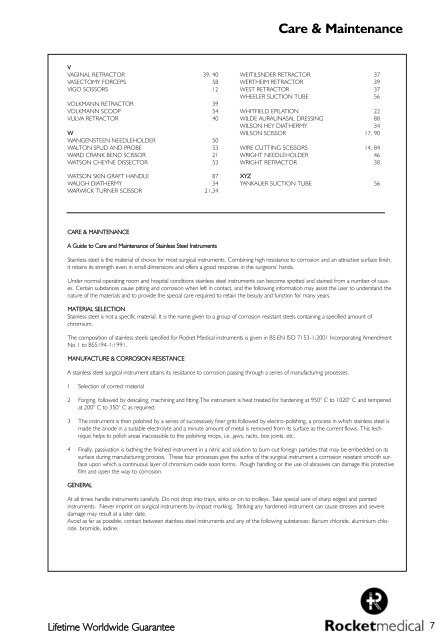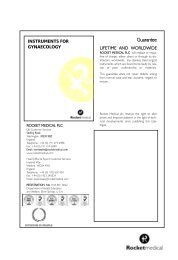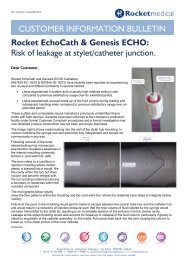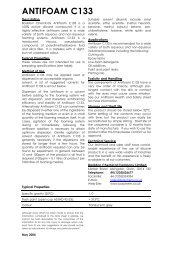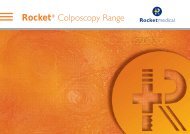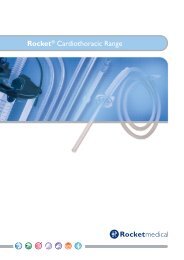scissors - Rocket Medical plc
scissors - Rocket Medical plc
scissors - Rocket Medical plc
You also want an ePaper? Increase the reach of your titles
YUMPU automatically turns print PDFs into web optimized ePapers that Google loves.
Care & Maintenance<br />
V<br />
VAGINAL RETRACTOR 39, 40 WEITILSNDER RETRACTOR 37<br />
VASECTOMY FORCEPS 58 WERTHEIM RETRACTOR 39<br />
VIGO SCISSORS 12 WEST RETRACTOR 37<br />
WHEELER SUCTION TUBE 56<br />
VOLKMANN RETRACTOR 39<br />
VOLKMANN SCOOP 54 WHITFIELD EPILATION 22<br />
VULVA RETRACTOR 40 WILDE AURAUNASAL DRESSING 88<br />
WILSON HEY DIATHERMY 34<br />
W WILSON SCISSOR 17, 90<br />
WANGENSTEEN NEEDLEHOLDER 50<br />
WALTON SPUD AND PROBE 53 WIRE CUTTING SCISSORS 14, 84<br />
WARD CRANK BEND SCISSOR 21 WRIGHT NEEDLEHOLDER 46<br />
WATSON CHEYNE DISSECTOR 53 WRIGHT RETRACTOR 38<br />
WATSON SKIN GRAFT HANDLE 87 XYZ<br />
WAUGH DIATHERMY 34 YANKAUER SUCTION TUBE 56<br />
WARWICK TURNER SCISSOR 21,34<br />
CARE & MAINTENANCE<br />
A Guide to Care and Maintenance of Stainless Steel Instruments<br />
Stainless steel is the material of choice for most surgical instruments. Combining high resistance to corrosion and an attractive surface finish,<br />
it retains its strength even in small dimensions and offers a good response in the surgeons’ hands.<br />
Under normal operating room and hospital conditions stainless steel instruments can become spotted and stained from a number of causes.<br />
Certain substances cause pitting and corrosion when left in contact, and the following information may assist the user to understand the<br />
nature of the materials and to provide the special care required to retain the beauty and function for many years.<br />
MATERIAL SELECTION<br />
Stainless steel is not a specific material. It is the name given to a group of corrosion resistant steels containing a specified amount of<br />
chromium.<br />
The composition of stainless steels specified for <strong>Rocket</strong> <strong>Medical</strong> instruments is given in BS EN ISO 7153-1:2001 Incorporating Amendment<br />
No 1 to BS5194-1:1991.<br />
MANUFACTURE & CORROSION RESISTANCE<br />
A stainless steel surgical instrument attains its resistance to corrosion passing through a series of manufacturing processes.<br />
I<br />
Selection of correct material<br />
2 Forging, followed by descaling, machining and fitting.The instrument is heat treated for hardening at 950° C to 1020° C and tempered<br />
at 200° C to 350° C as required.<br />
3 The instrument is then polished by a series of successively finer grits followed by electro-polishing, a process in which stainless steel is<br />
made the anode in a suitable electrolyte and a minute amount of metal is removed from its surface as the current flows. This technique<br />
helps to polish areas inaccessible to the polishing mops, i.e. jaws, racks, box joints, etc.<br />
4 Finally, passivation is bathing the finished instrument in a nitric acid solution to burn out foriegn particles that may be embedded on its<br />
surface during manufacturing process. These four processes give the surfce of the surgical instrument a corrosion resistant smooth surface<br />
upon which a continuous layer of chromium oxide soon forms. Rough handling or the use of abrasives can damage this protective<br />
film and open the way to corrosion.<br />
GENERAL<br />
At all times handle instruments carefully. Do not drop into trays, sinks or on to trolleys. Take special care of sharp edged and pointed<br />
instruments. Never imprint on surgical instruments by impact marking. Striking any hardened instrument can cause stresses and severe<br />
damage may result at a later date.<br />
Avoid as far as possible, contact between stainless steel instruments and any of the following substances: Barium chloride, aluminium chloride.<br />
bromide, iodine.<br />
Lifetime Worldwide Guarantee 7


